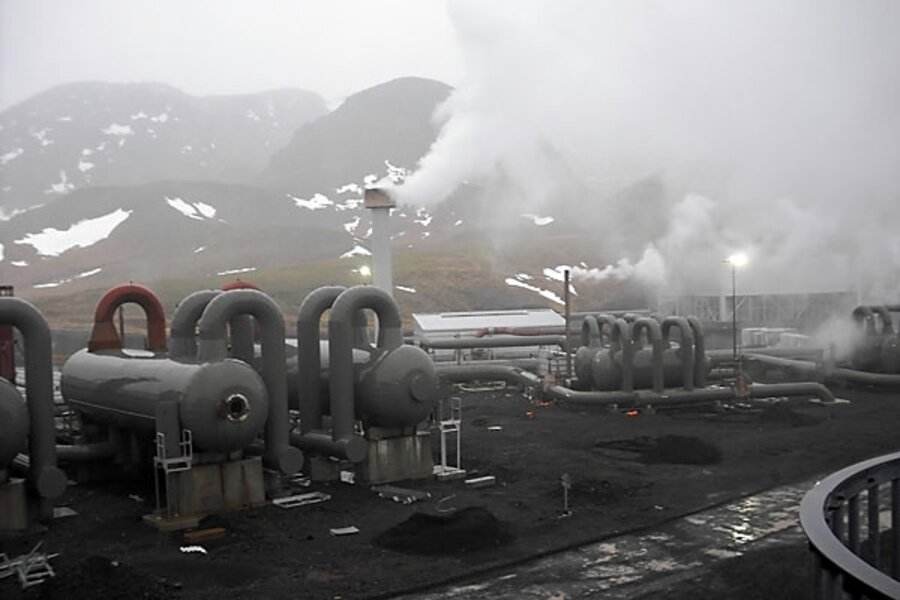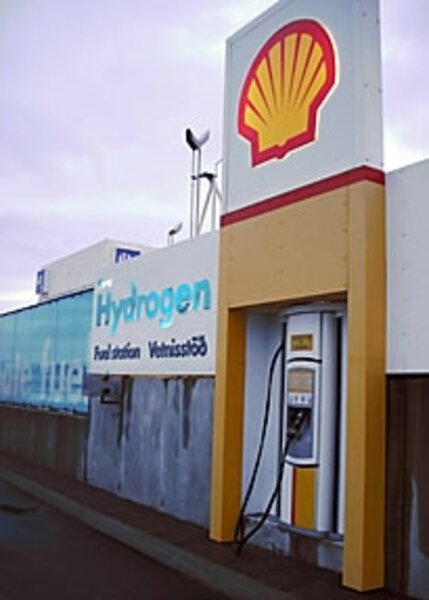Iceland strides toward a hydrogen economy
Loading...
| ReykjavÍk, Iceland
It looks much like any other filling station: Shell-branded gasoline pumps lined up before a brightly lit convenience store on the shoulder of a busy highway. But this is the hub of one of Iceland’s most ambitious projects, an obligatory stop for visiting foreign dignitaries that offers a glimpse of what might be the future of human transportation.
This is no ordinary Shell station. Just to one side, where you might expect to find diesel pumps, stands the world’s first commercial hydrogen fueling station. Pull up in your hydrogen-powered car, swipe your credit card, attach the pump fixture, and in five minutes you’ll be back on the road, your tank full of emissions-free fuel produced right at the filling station from water and sustainably generated electricity.
“It’s a completely green car, with only water coming out of the tailpipe,” says Jon Bjorn Skulason, general manager of Icelandic New Energy, who drives one of the city’s 14 hydrogen-fueled vehicles. “If we complete our plans, we will be a zero-emissions society. We would not have to import fuel from foreign sources, and we would be 100 percent sustainable, which must be the true future of the world.”
While many countries talk about sustainable energy and reducing greenhouse-gas emissions, Iceland is committed to weaning itself off fossil fuels altogether by the middle of the century. Instead of importing oil to power its cars and fishing vessels, this remote island nation of 300,000 plans to power them like everything else here: with electricity from hydroelectric and geothermal plants.
In recent decades, Icelanders have harnessed meltwater from massive ice sheets and the steam that pours from its volcano-dotted landscape, which together generate virtually all the island’s heat and electricity. In the dead of winter, Icelanders use geothermal heat to grow bananas in frost-covered greenhouses, and to warm the streets and sidewalks of central Reykjavík.
“Our power plants are essentially processing water,” says Eirikur Hjalmarsson, spokesman for Reykjavík Energy. Its geothermal power plants have become tourist attractions. “Since we’re generating electricity from renewable sources, it may make sense to use it to power vehicles.”
The government’s plan, announced in 1998, is to replace fossil fuels with hydrogen. Together with Daimler AG, Shell, Norsk Hydro, and local utilities and research institutions, they created Icelandic New Energy, the company charged with spearheading the effort. The Shell station opened in 2003, serving the needs of three experimental hydrogen fuel-cell buses that plied the streets of Reykjavík for four years without incident. Hydrogen-fueled cars followed in late 2007, and were joined by a fuel cell-equipped passenger vessel last year.
“We haven’t found any major problems with the operation of a hydrogen economy with buses, cars, or ships,” says Icelandic New Energy’s Mr. Skulason. “If somebody were to say to me today, ‘I’ll bring 20,000 hydrogen cars to Iceland every year for the next five years at the same cost as a conventional car,’ it would not be a problem for us.”
But the project, which aimed to convert the country to hydrogen by 2040, is several years behind schedule, due to delays in automobile manufacturers’ roll-out of the next generation of hydrogen vehicles, which the global recession will only make worse. Iceland’s own financial collapse has not only delayed the building of additional fueling stations, Skulason says, but has also underscored the need to develop domestic fuel supplies.
The idea is to use electricity generated by geothermal (steam) and hydro plants to power cars. While plug-in electric cars might be sensible for Reykjavík commuters, long-distance travelers, fishermen, and aircraft pilots have power and range requirements that can’t be practically served by battery storage alone, says Bragi Arnason, the University of Iceland chemist who first conceived Iceland’s “hydrogen experiment.”
“You will use electricity wherever you can, but batteries do not have a sufficient range – maybe 200 or 300 kilometers [124 to 186 miles],” he says, requiring that the electricity be stored in another, more intensive form. “Most experts agree that hydrogen is candidate fuel No. 1, because it’s the cheapest and easiest to make.”
At the Shell station, an electrolyzer strips hydrogen from H20 molecules, which are later consumed in the engines of specially-modified internal-combustion Toyota Priuses. The hydrogen can also be turned into electricity in the fuel cells of Daimler A-Class electric cars. (Drivers here say the latter approach delivers far more torque and power.)
Critics say this entire approach is illogical. “If you have renewable electricity, why would you buy an expensive electrolyzer to throw away some of that electricity making hydrogen, buy an expensive tank to store it, and put it in a vehicle just to make it into electricity again?” asks Joseph Romm of the Center for American Progress in Washington, author of “The Hype About Hydrogen.” “If Iceland hasn’t figured out that electricity is their future, they will soon.”
Standing on the deck of the fuel-cell-equipped whale-watching vessel Elding, mechanical engineer Hallmar Halldors disagrees.
Mr. Halldors, founder of Icelandic Hydrogen, is Reykjavík’s main hydrogen mechanic, servicing fuel-cell vehicles and designing a network of a dozen small hydrogen filling stations that would one day provide full coverage across the country.
“You just don’t get the range with batteries, and you could never use them for fishing vessels,” he says, noting that the latter are out at sea for weeks at a time. “The fuel-cell vehicles have proven very reliable and people really accept them.”
The Elding’s captain, Vignir Sigursveinsson, uses his vessel’s fuel cells to power the ship’s electrical system, allowing him to shut down the diesel engines altogether while observing whales. “It’s totally silent,” he says. “Now when we stop the engines, we really realize how loud the old generator was.”
The system has received coast guard certification and the Elding’s customers – many of them British tourists – haven’t expressed concern with having hydrogen on board. Its only waste product is steam, which Captain Sigursveinsson would like to harness to make cappuccinos. “It’s technically possible,” Halldors notes with a smile, “but the safety certifiers are very cautious.”
Switching the country to hydrogen will be a long process, says Professor Arnason, who has been advocating the move since the oil shocks of the 1970s. “”If you look back in history, every change from one type of energy to another – wood to coal, coal to oil – it always takes 50 years,” he says. “I will only see the first steps, but when my grandchildren are grown, I am sure we will have this new economy.”






